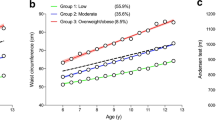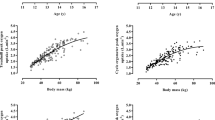Summary
Equations have been developed to predict the maximal oxygen intake (\(\dot V_{O_2 }\) (max) of pre-adolescent schoolchildren from anthropometric data. The analysis is based on a study of 22 boys and 23 girls aged 9–13 years, part of a random sample of Toronto schoolchildren. The 37 x-variates tested in a series of multiple regression equations include measurements of body surface area (BSA, m2), lean body mass (LBM, kg), age (A, months) kneefold thickness (K) arm extension force (AE, kg), trunk flexion force (TF, kg), arm girth (AG, cm), and summated strength index (∑S). The most promising equations, with their respective coefficients of variation (C. V.) are as follows: For boys 0.645 (BSA) + 0.0116 (A) + 0.0925 (K) − 1.085 (C. V. 13.5%) 0.0216 (LBM) + 0.0117 (A) + 0.105 (K) − 1.19 (C. V. 13.6%) −0.0099 (LBM) + 0.0030 (A) + 0.125 (K) + 0.0099 (∑S) − 0.34 (C. V. 9.7%) 0.0468 (AE) + 0.117 (K) + 0.23 (C. V. 11.3%) 0.0605 (AG) + 0.0242 (TF) + 0.065 (K) − 0.30 (C. V. 9.9%) For girls 1.127 (BSA) + 0.0058 (A) + 0.0327 (K) − 0.753 (C. V. 7.3%) 0.0480 (LBM) + 0.0050 (A) + 0.043 (K) − 0.89 (C. V. 8.1%) 0.0384 (LBM) + 0.0035 (A) + 0.043 (K) + 0.0020 (∑S) − 0.63 (C. V. 7.9%)
These equations predict the\(\dot V_{O_2 }\) (max) of the population studied with a greater accuracy than traditional procedures based on the response to submaximum exercise. The anthropometric approach to prediction of aerobic power merits further exploration.
Similar content being viewed by others
References
Cotes, J. E., Davies, C. T. M., Healy, M. J. R.: Factors relating to maximum oxygen intake in young adult male subjects. J. Physiol. (Lond.)189, 79P (1967).
—, Relationships of oxygen consumption, ventilation, and cardiac frequency to body weight during standardized sub-maximal exercise in normal subjects. Ergonomics12, 416–427 (1969).
—, Davies, C. T. M.: Factors underlying the capacity for exercise: a study in physical anthropometry. Proc. roy. Soc. Med.62, 620–624 (1969).
— —, Edholm, O. G., Healy, M. J. R., Tanner, J. M.: Factors relating to the aerobic capacity of 46 healthy British males and females, ages 18 to 28 years. Proc. roy. Soc. B,174, 91–114 (1969).
Davies, C. T. M.: Limitations to the prediction of maximum oxygen intake from cardiac frequency measurements. J. appl. Physiol.24, 700–706 (1968).
—, Tuxworth, W. T., Young, J. M.: Habituation to standardized exercise on a bicycle ergometer. J. Physiol. (Lond.)197, 268 (1968).
Hamley, E. J., Watson, J. R.: The relationship of maximum oxygen uptake to lean leg volume in young female athletes. J. Physiol. (Lond.)206, 28 (1970).
Rowell, L. B., Taylor, H. L., Wang, Y.: Limitations to predictions of maximum oxygen intake. J. appl. Physiol.19, 919–927 (1964).
Sendroy, J., Cecchini, L. P.: Determination of human body surface area from height and weight. J. appl. Physiol.7, 1 (1954).
Shephard, R. J., Allen, C., Benade, A. J. S., Davies, C. T. M., di Prampero, P. E., Hedman, R., Merriman, J. E., Myhre, K., Simmons, R.: Standardization of sub-maximal exercise tests. Bull. Wld Hlth Org.38, 765–775 (1968).
—, Bar-Or, O., Davies, C. T. M., Degré, S., Hedman, R., Ishii, K., Kaneko, M., LaCour, J. R., di Prampero, P. E., Seliger, V.: The working capacity of Toronto sohoolchildren. Canad. med. Ass. J.100, 560–566, 705–714 (1969).
—, Jones, G., Ishii, K., Kaneko, M., Olbrecht, A. J.: Factors affecting body density and thickness of sub-cutaneous fat. Amer. J. clin. Nutr.22, 1175–1189 (1969).
—, Standard tests of aerobic power.In: Frontiers of Fitness, Ed. Shephard, R. J. Springfield (Ill.): Thomas 1971.
—, The working capacity of schoolchildren.In: Frontiers of Fitness. Ed. Shephard, R. J. Springfield (Ill.): Thomas 1971.
—, Endurance Fitness. Toronto, Ont.: University of Toronto Press 1969.
Weiner, J. S., Lourie, J. A.: Human Biology. A guide to field methods. Oxford: Blackwell 1969.
Author information
Authors and Affiliations
Rights and permissions
About this article
Cite this article
Shephard, R.J., Weese, C.H. & Merriman, J.E. Prediction of maximal oxygen intake from anthropometric data. Int. Z. Angew. Physiol. Einschl. Arbeitsphysiol. 29, 119–130 (1971). https://doi.org/10.1007/BF00698022
Received:
Issue Date:
DOI: https://doi.org/10.1007/BF00698022




